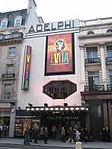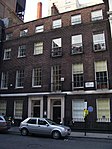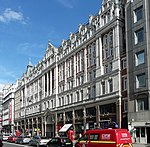Nell Gwynne Tavern
Covent GardenGrade II listed pubs in the City of WestminsterLondon building and structure stubsPub stubsUnited Kingdom listed building stubs ... and 1 more
Use British English from October 2014

The Nell Gwynne Tavern is a Grade II listed public house at 1–2 Bull Inn Court, Covent Garden, London, WC2.It is an early 19th-century refronting or rebuild of a 17th-century/18th-century house.
Excerpt from the Wikipedia article Nell Gwynne Tavern (License: CC BY-SA 3.0, Authors, Images).Nell Gwynne Tavern
Bull Inn Court, City of Westminster Covent Garden
Geographical coordinates (GPS) Address External links Nearby Places Show on map
Geographical coordinates (GPS)
| Latitude | Longitude |
|---|---|
| N 51.510233 ° | E -0.122824 ° |
Address
Nell Gwynne Tavern
Bull Inn Court
WC2E 7NJ City of Westminster, Covent Garden
England, United Kingdom
Open on Google Maps









